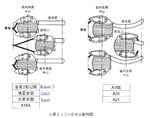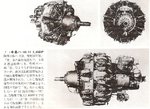This thread goes on par with the other one about the Nakajima Kotobuki, as this engine may be considered a close relative
The Ha-41/109 (Army type 2 Radial ???) share the same bore, stroke and possibly head design with the Nakajima Kotobuki model 3 engine. It's a compact two row, 14 cylinder radial engine. It was used in the Ki-44 interceptor and in the Ki-49 twin engined medium bomber. It's slightly smaller and lighter than contemporary engines of similar layout and capacity (37.5 liters, 1500 HP class) and gave good service.
Nakajima Ha-5/41/109:
14 cylinders, two row, air cooled radial engine.
Lenght: ???mm
Diameter: 1260mm
Weight: 630Kg (Ha-5/41), 720Kg (Ha-109)
Bore: 146mm
Stroke: 160mm
Capacity: 37.5 liters
Compression ratio: 6.7:1
Supercharged: yes, 8.39x (Ha 5/41); 6.55x and 8.66x (Ha-109)
Redution gear: 0.6875x (11/16 gear mesh)
Fuel: Gasoline (RON ???)
Performance data:
Ha-5: 890 HP @ 2200 rpm, -50mm Hg, 4700 meters
Ha-41: 1260 HP @ 2450 rpm, +150mm Hg, 3700 meters
Ha-109: 1440 HP @ 2600 rpm, +200mm Hg, 5200 meters (highest blower setting)
Take off power:
Ha-5: 950 HP @ 2200 rpm, +50mm Hg
Ha-41: 1260 HP @ 2500 rpm, +250mm Hg
Ha-109: 1500 HP @ 2650 rpm, +30omm Hg
I'm looking for any additional info and good resolution photos, drawing, schematics, etc about this engine. Since there's no surviving Ki-44 or Ki-49 airplane, I know info is hard to find. I think at NASM there's one engine (possibly from a Ki-44) preserved in storage. Maybe someone can share more info on it.
The Ha-41/109 (Army type 2 Radial ???) share the same bore, stroke and possibly head design with the Nakajima Kotobuki model 3 engine. It's a compact two row, 14 cylinder radial engine. It was used in the Ki-44 interceptor and in the Ki-49 twin engined medium bomber. It's slightly smaller and lighter than contemporary engines of similar layout and capacity (37.5 liters, 1500 HP class) and gave good service.
Nakajima Ha-5/41/109:
14 cylinders, two row, air cooled radial engine.
Lenght: ???mm
Diameter: 1260mm
Weight: 630Kg (Ha-5/41), 720Kg (Ha-109)
Bore: 146mm
Stroke: 160mm
Capacity: 37.5 liters
Compression ratio: 6.7:1
Supercharged: yes, 8.39x (Ha 5/41); 6.55x and 8.66x (Ha-109)
Redution gear: 0.6875x (11/16 gear mesh)
Fuel: Gasoline (RON ???)
Performance data:
Ha-5: 890 HP @ 2200 rpm, -50mm Hg, 4700 meters
Ha-41: 1260 HP @ 2450 rpm, +150mm Hg, 3700 meters
Ha-109: 1440 HP @ 2600 rpm, +200mm Hg, 5200 meters (highest blower setting)
Take off power:
Ha-5: 950 HP @ 2200 rpm, +50mm Hg
Ha-41: 1260 HP @ 2500 rpm, +250mm Hg
Ha-109: 1500 HP @ 2650 rpm, +30omm Hg
I'm looking for any additional info and good resolution photos, drawing, schematics, etc about this engine. Since there's no surviving Ki-44 or Ki-49 airplane, I know info is hard to find. I think at NASM there's one engine (possibly from a Ki-44) preserved in storage. Maybe someone can share more info on it.


